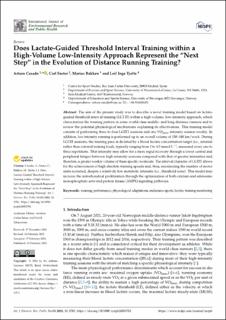| dc.contributor.author | Casado, Arturo | |
| dc.contributor.author | Foster, Carl | |
| dc.contributor.author | Bakken, Marius | |
| dc.contributor.author | Tjelta, Leif Inge | |
| dc.date.accessioned | 2023-05-23T14:09:33Z | |
| dc.date.available | 2023-05-23T14:09:33Z | |
| dc.date.created | 2023-04-20T12:48:15Z | |
| dc.date.issued | 2023 | |
| dc.identifier.citation | Casado, A., Foster, C., Bakken, M., & Tjelta, L. I. (2023). Does Lactate-Guided Threshold Interval Training within a High-Volume Low-Intensity Approach Represent the “Next Step” in the Evolution of Distance Running Training?. International Journal of Environmental Research and Public Health, 20(5), 3782. | en_US |
| dc.identifier.issn | 1661-7827 | |
| dc.identifier.uri | https://hdl.handle.net/11250/3068720 | |
| dc.description.abstract | The aim of the present study was to describe a novel training model based on lactate-guided threshold interval training (LGTIT) within a high-volume, low-intensity approach, which characterizes the training pattern in some world-class middle- and long-distance runners and to review the potential physiological mechanisms explaining its effectiveness. This training model consists of performing three to four LGTIT sessions and one VO2max intensity session weekly. In addition, low intensity running is performed up to an overall volume of 150–180 km/week. During LGTIT sessions, the training pace is dictated by a blood lactate concentration target (i.e., internal rather than external training load), typically ranging from 2 to 4.5 mmol·L−1, measured every one to three repetitions. That intensity may allow for a more rapid recovery through a lower central and peripheral fatigue between high-intensity sessions compared with that of greater intensities and, therefore, a greater weekly volume of these specific workouts. The interval character of LGTIT allows for the achievement of high absolute training speeds and, thus, maximizing the number of motor units recruited, despite a relatively low metabolic intensity (i.e., threshold zone). This model may increase the mitochondrial proliferation through the optimization of both calcium and adenosine monophosphate activated protein kinase (AMPK) signaling pathways. | en_US |
| dc.language.iso | eng | en_US |
| dc.publisher | MDPI | en_US |
| dc.rights | Navngivelse 4.0 Internasjonal | * |
| dc.rights.uri | http://creativecommons.org/licenses/by/4.0/deed.no | * |
| dc.title | Does Lactate-Guided Threshold Interval Training within a High-Volume Low-Intensity Approach Represent the “Next Step” in the Evolution of Distance Running Training? | en_US |
| dc.type | Peer reviewed | en_US |
| dc.type | Journal article | en_US |
| dc.description.version | publishedVersion | en_US |
| dc.rights.holder | The authors | en_US |
| dc.subject.nsi | VDP::Samfunnsvitenskap: 200::Samfunnsvitenskapelige idrettsfag: 330 | en_US |
| dc.source.volume | 20 | en_US |
| dc.source.journal | International Journal of Environmental Research and Public Health | en_US |
| dc.source.issue | 5 | en_US |
| dc.identifier.doi | 10.3390/ijerph20053782 | |
| dc.identifier.cristin | 2142126 | |
| cristin.ispublished | true | |
| cristin.fulltext | original | |
| cristin.qualitycode | 1 | |

